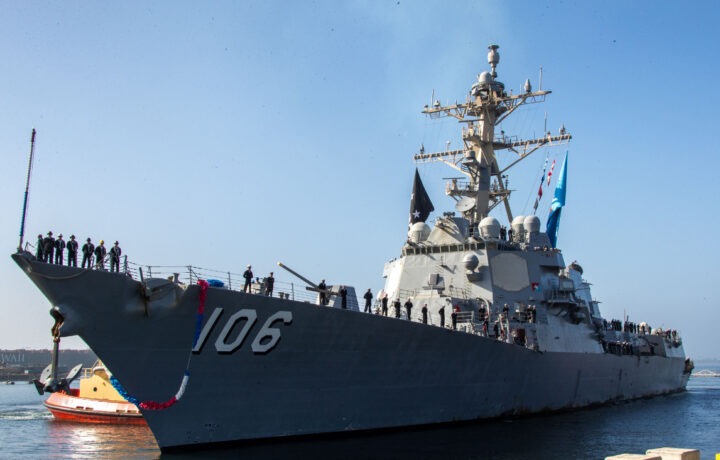Recently, the United States Navy’s Arleigh Burke-class guided-missile destroyer USS Stockdale (DDG-106) departed Naval Base San Diego and began operating in the United States Northern Command (USNORTHCOM) area of responsibility. It is now the third destroyer to conduct southern border operations, taking over for the USS Spruance (DDG-111), which carried out similar operations.
“Stockdale’s departure reinforces the Navy’s role in the Department of Defense’s coordinated effort in response to the Presidential Executive Order. Stockdale’s sea-going capacity contributes to USNORTHCOM’s ability to protect the United States’ territorial integrity, sovereignty, and security, through a coordinated, multi-domain strategy,” U.S. Fleet Forces Command announced.
USS Stockdale will continue operations with an embarked U.S. Coast Guard Law Enforcement Detachment (LEDET) team that is trained to carry out maritime interdiction. That enables the ship to address a range of challenges from countering illegal activities to supporting homeland security and even humanitarian efforts.
The USS Gravely (DDG-107) was deployed from Naval Station Mayport, Florida, last month and is operating near the coast of Florida, Alabama, Mississippi, and Louisiana. DDG-106 will take over for DDG-111 in patrolling the waters near San Diego.
Back From the Middle East
As with the other two destroyers, USS Stockdale had previously deployed to the Middle East – in this case with the Abraham Lincoln Carrier Strike Group (ABECSG). While operating in the Red Sea, the guided-missile destroyer successfully repelled multiple Iranian-backed Houthi attacks while transiting the Bab el-Mandeb Strait and conducting escort operations of U.S.-flagged vessels in the Gulf of Aden.
During those engagements, USS Stockdale engaged and defeated one-way attack uncrewed aerial-ship cruise missiles, Fleet Forces Command added.
The destroyer received no damage, while no personnel were hurt in the months-long deployment.
Destroyers on Each Coast
USNORTHCOM appears to be maintaining at least one guided-missile destroyer in the Pacific and another in the Gulf of Mexico and the Caribbean to support the U.S. military and the Department of Homeland Security’s ongoing effort to address the border crisis.
USS Spruance deployed from San Diego on March 22, and during its patrols, the destroyer helped rescue 18 people from a disabled vessel about 50 miles from shore. According to a social media post from USNORTHCOM, the warship also aided in apprehending a vessel suspected of carrying 13 undocumented people aboard.
To casual observers, it might seem like overkill to deploy warships that literally countered anti-ship missiles to now patrol the waters around the southern United States. However, as MilitaryTimes reported, “Criminal organizations use a wide variety of vessels and seaborne craft to get illicit drugs into the U.S. These can include fishing boats and submersibles, which are being increasingly operated remotely using new technology.”
A Real War on Drugs
During the first Trump administration, the U.S. Navy deployed destroyers, Littoral Combat Ships (LCS), and Expeditionary Fast Transport vessels to the Caribbean and East Pacific to conduct drug interdiction patrols.
Since returning to the White House, the U.S. has deployed thousands of personnel to the border, while the U.S. Navy is conducting intelligence, surveillance, and reconnaissance (ISR) flights with its Boeing P-8A Poseidon multi-mission maritime patrol and reconnaissance aircraft. The U.S. Air Force also has been carrying out surveillance flights along the U.S.-Mexico border with the Cold War-era Lockheed U-2 “Dragon Lady” spy plane.
The U.S. Navy is likely to continue to rotate the agile Arleigh Burke-class destroyers, but last month deployed the USS Minneapolis-St. Paul (LCS-21), a Freedom-class LCS, to aid in counter-drug smuggling missions. It could be argued this is the mission that the problem-prone warships might be best suited to.
“It’s not only vital for the United States to have control of our border via land. It’s equally important to control our territorial waters, and this deployment directly supports U.S. Northern Command’s mission to protect our sovereignty,” Pentagon Chief Spokesman Sean Parnell told reporters last month.
President Trump has made securing the border a top priority of his administration.
“Our southern border is under attack from a variety of threats,” Trump wrote in a memo last Friday. “The complexity of the current situation requires that our military take a more direct role in securing our southern border than in the recent past.”
Yet, as previously reported, it may not just be the U.S. military and law enforcement that are paying attention to movement along the border, as Mexico’s notorious drug cartels are also using drones to monitor U.S. military personnel. The danger is that a very real drug war could be heating up.




